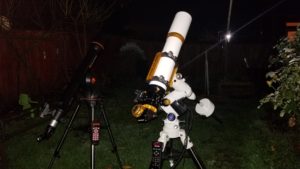By: Vlad Fedosov
Intro:
I think that most of us at one point or another get the refractor bug. The refractor bug has always had its hold on me. Some of the refractors that I have owned at one point or another include: Tasco 60mm, Meade AR152, Celestron c102, TeleVue(TV) TV-85, TeleVue NP101, William Optics(WO) 80mm FD, Meade 127ED, Astro Tech 80mm AT CF, Explore Scientific AR-102, Explore Scientific AR-127, ETX-60, ETX-70, and finally the William Optics GT 102! As you can see I have had a bit of experience with refractors, and have defiantly been on the hunt for the perfect specimen. The William Optics GT 102 triplet(FPL53 glass) APO is defiantly one of the finest refractors that I have owned. My particular scope came outfitted with a 3” Feather Touch Focuser. The focal length of the scope is 703mm and the OTA weights approximately 11.1lb(with stock focuser). Let’s take a look at what this fine scope can do!

Testing:
I tested the WO GT102 over a period of about 6 months both from my mag 4 backyard and several dark sky sites. I will begin by saying that I’m quite a fan of the craftsmanship of William Optics scopes in general. I have always liked the aesthetics of them and have found that they are just very well built. As stated earlier my particular GT 102 came mated with a 3” Feather Touch Focuser that made the scope an even finer instrument and a pure joy to use. The focuser was mated with the William Optics RoboLock. I also had the WO RoboLock diagonal. This combo was a pure pleasure to use with one exception. Every single time that I used the scope I dreaded the RoboLocks. I guess my issue with them is the number of times you have to turn them to get the eyepiece disengaged and secured. It requires around 5 full revolutions to do this. Once disengaged I still found it difficult to put eyepieces into the diagonal. When the eyepiece was finally in the diagonal I never felt that I had it secure enough that my $800 25mm 100° Explore Scientific eyepiece would not fall straight to the ground. The 3” Feather Touch Focuser itself is the best money can buy. It is smooth and very precise. It looks just as good as it performs!
Onto the optics. The optics are about what I would expect from this class of scope. They produce a perfect airy disk and very sharp false color free images. The only unwanted color that I have ever seen with the scope is on Sirius. There was a very faint purple halo around the extremely bright star. In comparison, the AstroTech AT 80mm ED doublet displays at least 3 times the amount of color on Sirius. Double star performance it an absolute dream with the perfect optics. I regularly resolved stars to the limit of seeing in my area, and do not recall a day when I could not resolve a tight double that was limited by the small aperture vs the seeing. Planetary performance is also about as good as you can get from a 4” scope.
I think a lot of people that have not had a chance to experience an APO in this class have a perception that an APO somehow bends the laws of Physics when it comes to planetary and deep sky objects(DSO) performance. I can tell you that while yes, a quality 4” APO does give you near 100% of what a 4” scope can produce, but it does not produce even a tiny bit more than is possible with a 4″ scope. DSO do look really good in an APO due to the very tight beautiful stars in the field and the excellent contrast. Having said that an 8” scope of any design will show DSO much, much better. When I use my 12” Meade LX-200-R(ACF) or my 16” Lightbridge there is zero comparison in the WOW factor in the view of DSO.
Conclusion:
In conclusion, I want to say that I consider this to be the finest refractor that I have owned. Yes even compared to the TV NP101. Not because I think the optics are better on the WO then the TV, but because the entire scope fit, finish, and mechanics, when mated with the Feather Touch focuser, are just better. I do feel that if the unthinkable day came to where I had to only pick one scope to own, a high end 4” refractor like the WO GT 102 would be right on top of my list. It just checks off so many requirements of the hobby: wide fiend views, planetary observing, decent DSO performance, grab & go setup, virtually no maintenance, excellent for astrophotography… If you have dreamed about such a scope, I would encourage you to forget about the high price tag and just do it at least once in your lifetime. Just buy one, you will not regret it(as long as you have reasonable expectations)!
